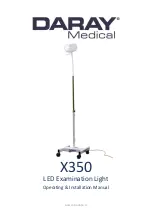
©
Elation Professional
® -
www.elationlighting.com - Protron Color™ Instruction Manual Page 6
©
Elation Professional
® -
www.elationlighting.com - Protron Color™ Instruction Manual Page 5
Protron Color™
DMX Set Up
Protron Color™
DMX Set Up
Power Supply:
Before plugging your unit in, be sure the source volt-
age in your area matches the required voltage for your Elation
®
Pro-
tron Color.™ The Elation
®
Protron Color
™
is 120v only. Because line
voltage may vary from venue to venue, you should be sure your unit
voltages matches the wall outlet voltage before attempting to operate
you fixture.
DMX-512:
DMX is short for Digital Multiplex. This is a universal pro-
tocol used as a form of communication between intelligent fixtures
and controllers.
A DMX controller sends DMX data instructions from
the controller to the fixture. DMX data is sent as serial data that trav-
els from fixture to fixture via the DATA “IN” and DATA “OUT” XLR ter-
minals located on all DMX fixtures (most controllers only have a DATA
“OUT” terminal).
DMX Linking:
DMX is a language allowing all makes and models of
different manufactures to be linked together and operate from a sin-
gle controller, as long as all fixtures and the controller are DMX com-
pliant.
To ensure proper DMX data transmission, when using several
DMX fixtures try to use the shortest cable path possible. The order
in which fixtures are connected in a DMX line does not influence the
DMX addressing. For example; a fixture assigned a DMX address of 1
may be placed anywhere in a DMX line, at the beginning, at the end,
or anywhere in the middle. When a fixture is assigned a DMX address
of 1, the DMX controller knows to send DATA assigned to address 1
to that unit, no matter where it is located in the DMX chain.
Dipswitches in DMX mode:
This unit uses dipswitches to assign a
DMX address. Each dipswitch represents a binary value.
Dipswitch 1 address equals 1
Dipswitch 2 address equals 2
Dipswitch 3 address equals 4
Dipswitch 4 address equals 8
Dipswitch 5 address equals 16
Dipswitch 6 address equals 32
Dipswitch 7 address equals 64
Dipswitch 8 address equals 128
Dipswitch 9 address equals 256
Dipswitch 10 - Some units omit dipswitch 10. When a unit does
include dipswitch #10, it is usually used for special functions such as
sound activation.
Assigning DMX Address:
Each dipswitch has a preset value. A spe-
cific DMX address is set by combining the dipswitches that sum your
desired value. For example: To achieve a DMX address of 7, combine
dipswitches 1, 2, and 3. Since dipswitch 1 has a value of 1, dipswitch
2 has a value of 2, and dipswitch 3 has a value of 4, the combination
of the three create a DMX value of 7. (See example below).
Set DMX address 1:
Set DMX address 7:
Dip-switches # 1 = 1
Dip-switches # 1 = 1
2 = 2
3 = 4
= 7
Data Cable (DMX Cable) Requirements (For
DMX and Master/Slave Operation):
The Protron
Color™ can be controlled via DMX-512 protocol.
The Protron Color™ is a five channel DMX unit.
The DMX address is set on the side panel of the
Protron Color™ Your unit and your DMX controller
require a standard 3-pin XLR connector for data
input and data output (Figure 1). If you are making
your own cables, be sure to use standard two con-
ductor shielded cable (This cable may be purchased at almost all pro
sound and lighting stores). Your cables should be made with a male
and female XLR connector on either end of the cable. Also remember
that DMX cable must be daisy chained and can not be split.
Notice:
Be sure to follow figures two and three when making your own
cables. Do not use the ground lug on the XLR connector. Do not con-
nect the cable’s shield conductor to the ground lug or allow the shield
conductor to come in contact with the XLR’s outer casing. Grounding
the shield could cause a short circuit and erratic behavior.
DMX512 IN
3-PIN XLR
SOUND
REMOTE
CONTROL
INPUT
POWER
INPUT
OUTPUT
SOUND
REMOTE
CONTROL
INPUT
POWER
INPUT
OUTPUT
SOUND
REMOTE
CONTROL
INPUT
POWER
INPUT
OUTPUT
DMX512
DMX+,DMX-,COMMON
1
2
3
Termination reduces signal errors and
avoids signal transmission problems
and interference. It is always advisable
to connect a DMX terminal, (Resistance
120 Ohm 1/4 W) between PIN 2 (DMX-)
and PIN 3 (DMX +) of the last fixture.
1
2
3
1
2
3
DMX +
DMX -
COMMON
DMX512 OUT
3-PIN XLR
Figure 2
Figure 1


























